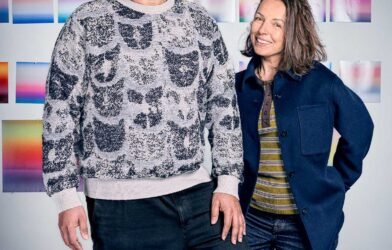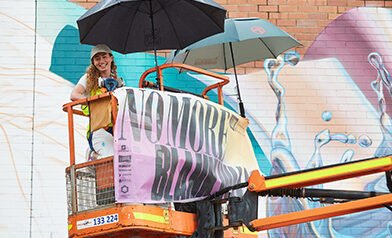Installation view of “Ed Clark,” Turner Contemporary, Margate, Kent, UK (May 25–Sept. 1 2024). | © Courtesy Turner Contemporary, Photo by Thierry Bal
AN ORIGINAL FIGURE in Post-War Abstraction, Ed Clark (1926-2019) is recognized for his innovation and experimentation. He made paintings distinguished by their energy, drama, and generous strokes of seductive color achieved with a wide-width push broom, rather than a paint brush. Recently opened, “Ed Clark” at Turner Contemporary in Margate, UK, is the artist’s first institutional exhibition in Europe.
Born in New Orleans, La., Clark left high school in 1944 to serve in the U.S. Air Force and went on to study at the Art Institute of Chicago and L’Academie de la Grande Chaumière in Paris, France. His time living and working in Paris was influenced by artists Nicolas de Staël, Pierre Soulages, and Jean-Paul Riopelle and shaped by connections with his African American peers—expatriate artists and writers Beauford Delaney, Barbara Chase-Riboud, Richard Wright, and James Baldwin.
After working in figuration early on, it was in Paris that the American artist turned to abstraction and embarked upon a career defined by his development of new methods and inventive approaches. Active over seven decades, Clark divided his time between New York and Paris and also traveled to Africa, Asia, Latin America, Cuba, Martinique, and Crete, where he visited his friend and fellow abstract artist Jack Whitten at his summer home. In his final years, Clark lived in Detroit.
Following extensive international experience and a long, hard-fought exhibition history in galleries at home and abroad, Clark’s first show at a European institution has arrived five years after his passing. The exhibition features nearly 20 paintings—stunning abstractions, including one oval painting and one shaped canvas, along with archival materials.
Ed Clark made paintings distinguished by their energy, drama, and generous strokes of seductive color achieved with a wide-width push broom, rather than a paint brush.
ED CLARK, “Blacklash,” 1964. | © The Art Institute of Chicago / Art Resource, N.Y.
More than three dozen photographs and documents are on display, ephemera that sheds light on Clarks’s diverse experiences. The materials include original pages from Clark’s sketchbook, circa late 1940s–early 50s; a letter to the artist from his parents sent in the first months after he moved to Paris (circa 1950s); and the layout of a show at Galerie Raymond Creuze in Paris, believed to be Clark’s first-ever solo exhibition (1956).
Also featured is a suggestion for mixing oil paint from Willem de Kooning (circa 1956–66); an image of Clark, Beauford Delaney and Hedy Clark (the artist’s third wife) at the American Center for Artists in Paris (1969), where the exhibition “Les Trois Noirs USA,” featuring Clark, Bill Hutson and Sam Middleton was on view; and an image by Dwight Carter from the shoot commissioned for Black Enterprise magazine’s special issue The Business of Black Art, picturing Clark in his studio in 1975, with works from his Ife Series (1974).
There are images of Clark working in front of the Great Pyramids and Sphinx in Giza, Egypt (1997); in his temporary studio in Bahia, Brazil (1988); and pictured with artist Yayoi Kusama (fellow co-founder of Brata Gallery on New York’s Lower East Side) in Kusama’s studio in Tokyo, Japan (1988).
A 1979 letter to Clark proposing a solo exhibition at The Studio Museum in Harlem is also among the selections (“Edward Clark: A Complex Identity was presented at the Studio Museum in 1980); along with an exhibition booklet documenting “Three Masters” (featuring Clark, Ernest Critchlow and Herbert Gentry) at Robert Gallery, James E. Lewis Museum of Art, Morgan State University in Baltimore, Md. (1994); and a 2010 photograph of Clark pictured with his self-portrait, which he started in 1947 and completed in 1949.
“I’m going to draw and paint better than anybody.” — Ed Clark
ED CLARK, Self Portrait, 1947-9 (watercolor on board, 11½ x 14½ inches). | © The Estate of Ed Clark. Courtesy Estate and Hauser & Wirth
In 2014, Whitten interviewed Clark for BOMB magazine. He asked, “When did you know you were an artist, absolutely?” Clark responded:
-
When I did the self-portrait [1947-1949]. But when I did it, no one was looking over my shoulder. That was done in my house. I was studying Art History and Art [at the Art Institute of Chicago]. They got to da Vinci before Michelangelo, who I like better now. I saw the Mona Lisa. I hadn’t been to France yet, but I saw [pictures of] it. I said, I’m going to draw and paint better than anybody. I didn’t even have oil paint. They didn’t have acrylic then. I didn’t know what to do. I took watercolor, the cheap tube kind. Painted it on a board. Of course, it did funny things, and I kept it on until I built it up, built it up. For two years I’m working on the thing. Ain’t nobody else can show me any painting in this country better than that, from my point of view.
That self portrait, the early painting that Clark spoke so confidently and proudly about, is featured at Turner Contemporary, displayed along with the grand abstract works he produced in the decades following and today nearly exclusively represent his practice. CT
Ed Clark is on view at Turner Contemporary in Margate, Kent, UK, from May 25-Sept. 1, 2024
FIND MORE about Ed Clark on the website of his estate
FIND MORE about Ed Clark from an interview with the artist conducted by Jack Whitten for BOMB magazine (2014) and a conversation about Clark, between his daughter Melanca Clark and curator Allie Biswas, published in Hauser & Wirth’s Ursula magazine (2022)
ED CLARK, “Locomotion,” 1963. | © The Estate of Ed Clark. Courtesy the Estate and Hauser & Wirth. Photo by Thomas Barratt
Installation view of “Ed Clark,” Turner Contemporary, Margate, Kent, UK (May 25–Sept. 1 2024). | © Courtesy Turner Contemporary, Photo by Thierry Bal
Ed Clark in his New York studio, 1975. | © The Estate of Ed Clark. Photo by Dwight Carter
ED CLARK, “Maple Red,” 1963. | Detroit Institute of Arts. © The Estate of Ed Clark. Courtesy the Estate of Ed Clark and Hauser & Wirth
ED CLARK, Untitled, 1970. | © The Estate of Ed Clark. Courtesy the Estate of Ed Clark and Hauser & Wirth. Photo by Damian Griffiths
Installation view of “Ed Clark,” Turner Contemporary, Margate, Kent, UK (May 25–Sept. 1 2024). | © Courtesy Turner Contemporary, Photo by Thierry Bal
ED CLARK, Untitled, circa 1976. | © The Estate of Ed Clark. Courtesy the Estate of Ed Clark and Hauser & Wirth
ED CLARK, Untitled. 1957. | The Art Institute of Chicago. © The Art Institute of Chicago / Art Resource, N.Y. Photo by Elyse Allen
Installation view of “Ed Clark,” Turner Contemporary, Margate, Kent, UK (May 25–Sept. 1 2024). | © Courtesy Turner Contemporary, Photo by Thierry Bal
BOOKSHELF
“Ed Clark: Big Sweep, Chronicles of a Life, 1926–2019” was published on the occasion of a 2023 exhibition at Hauser & Wirth gallery in New York. In 2018, Mnuchin Gallery published “Ed Clark: A Survey,” which is now out of print. Also consider, “1971: A Year in the Life of Color” by Darby English and “Americans in Paris: Artists Working in Postwar France, 1946–1962.”





















